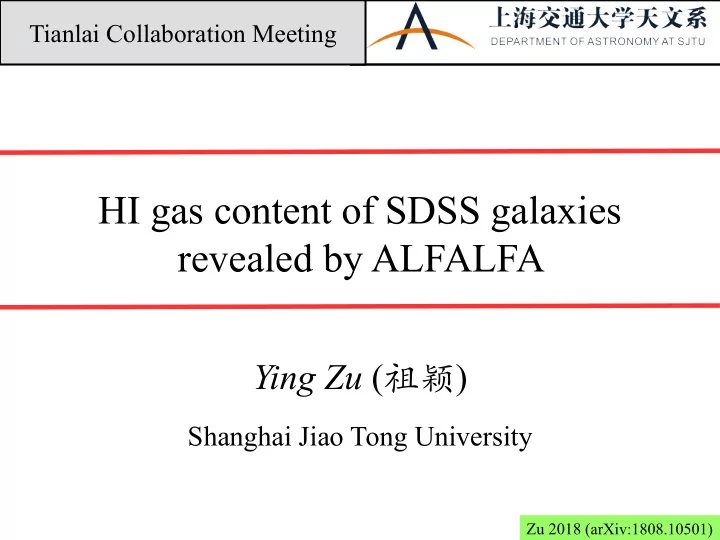

Tianlai Collaboration Meeting HI gas content of SDSS galaxies revealed by ALFALFA Ying Zu ( 祖颖 ) Shanghai Jiao Tong University Zu 2018 ( arXiv:1808.10501)
Galaxy Formation: Baryon Cycling HI disc Tulimson et al. 2018
Galaxy Formation in Intensity Mapping Context Galaxy positions Intensity Mapping Red: galaxies above flux limit Figure courtesy: Patrick Breysse
First cosmological detection of HI intensity map Cross-correlation between GBT IM & DEEP2 gal. at z=0.8 Chang et al. 2010
Galaxy-HI cross-spectrum measures HI mass Galaxy-HI cross P(k) Shot noise Woltz et al. 2017
Synergy btw Ti Tianlai IM & DESI Br Brig ight Gala alaxy xy Sur urvey • DESI BGS: >10 million galaxies, median z ~ 0.2 • Takes place during bright time • Two priority Tiers: r<19.5 and 19.5<r<20.0 • 14,000 sq deg with 3 passes of sky • Like SDSS, but bigger and deeper!
We need to understand the connection between galaxy optical properties and HI gas content in the local Universe Arecibo SDSS
ALFALFA Survey The Arecibo Legacy Fast ALFA (ALFALFA) survey is the largest blind extragalactic HI survey of the local HI universe to date. The completed ALFALFA survey has detected more than 30,000 extragalactic HI line sources out to z~0.06. Great synergy with optical surveys like the SDSS.
Can we predict HI content directly from stars?
Joint SDSS-ALFALFA Sample Zu 2018 ( arXiv:1808.10501)
HI-to-stellar Mass Ratio (HI fraction) Kannappan 2004 Zhang et al 2009 Li et al 2012 But current HI surveys suffer severe Malmquist bias
Malmquist Bias in ALFALFA SDSS Galaxy Number Ideal ALFALFA w/out Malmquist bias Real ALFALFA with Malmquist bias Redshift
Malmquist Bias: Likelihood has two components N galaxies in SDSS volume-limited sample, n of which were HI-detected, and N-n were non-detections. Zu 2018 ( arXiv:1808.10501)
Zu 2018 ( arXiv:1808.10501)
Observed HI fraction vs. expected HI Fraction Zu 2018 ( arXiv:1808.10501)
No Bias in the HI predictor Biased estimator
HI Mass function: non-detections accounted for Zu 2018 ( arXiv:1808.10501)
Metallicity: Star Formation vs. Gas Accretion Metal production: stellar nucleosynthesis yield from star formation Metal loss: metal expulsion due to outflows driven by star formation Metal dilution: Accretion of pristine gas from the IGM
Mass-Metallicity Relation (MZR) Tremonti et al. 2004
Star Formation Rate (SFR) dependence of MZR Tremonti+2004 metallicity Mannucci+2010 metallicity Yates et al. 2012
HI Excess: Deviation of obs. HI fraction from expectation
Metallicity depends on Relative sSFR and HI excess Zu 2018 ( arXiv:1808.10501)
Metallicity: Star Formation < GasAccretion? Zu 2018 ( arXiv:1808.10501)
Metallicity: Star Formation < GasAccretion? Metal production: stellar nucleosynthesis yield from star formation Metal loss: metal expulsion due to outflows driven by star formation Metal dilution: Accretion of pristine gas from the IGM
HI Excess should depend on large-scale environment
HI contour on SDSS image Outskirt of Vi Virgo Po Positive HI Excess? Inside Vi Virgo Ze Zero HI Excess? Center of Vi Virgo Ne Negat gative HI HI Excess? Chung et al. 2009
Weak anti-correlation btw HI excess and Average HI Excess Zu 2018 ( arXiv:1808.10501)
Cross-correlation btw red/blue galaxies and HI HI-rich HI-poor Blue Red Zu 2018 ( arXiv:1808.10501)
is likely caused by gas stripping in clusters Ram pressure stripping removes the cold gas reservoir on much shorter time scale (< 1 Gyr) than quenching (~ a few Gyrs). Satellite galaxies can still form stars while gradually being quenched after infall (see Wetzel+ 2013; Simha+ 2014) Kronberger et al. 2007
Conclusions We develop a method to predict HI fraction from stellar mass and color , q using a joint SDSS-ALFALFA sample. Potentially useful for understanding the cross-spectrum between Tianlai IM and DESI BGS galaxies. We eliminate the impact of Malmquist bias of HI detections on the predictor by q properly accounting for the HI-detection probability of each SDSS galaxy in the analysis. The predictor has an estimated scatter of 0.27 dex . We demonstrate that the HI excess is likely the main driver of the scatter in the q mass-metallicity relation, a key ingredient in solving galactic baryon cycling. The environmental dependence of HI can be effectively captured by a cross- q correlation coefficient between HI excess and red galaxy overdensity (-0.18). Important for understanding the cross-correlation coefficient between galaxies and HI intensity map.
Recommend
More recommend